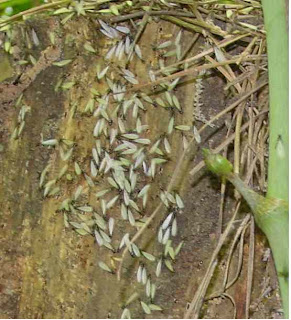The season has arrived when my office will be filled with small envelopes, medicine vials, fruit jars, cups and plastic bags containing very small winged insects. These containers will be brought by very nervous people who will want to know if their houses are threatened by these tiny insects. Termite swarming season is here, and tiny gossamer winged insects can be seen flying in small clouds. If you are unlucky these insects will be found flying within your house, emerging from tiny holes in your wall. More unnerving is to find small clumps or sprinklings of tiny insect wings upon the window sills of your home. Unfortunately if this is the case, it means that the termites have been active within the structure for three to five years. For termites to live is to eat and to eat means wood is being consumed and structural integrity is being threatened. Formosan Subterranean Termites colonies can consume up to a thousand pounds of wood a year due to the large number of termites within their colonies. Native subterranean termite colonies are much smaller and the damage they cause occurs at a slower rate.
Confusion reigns because the ants that are swarming this time of year are very similar in appearance to termites. Both are of similar size and shape and color, both have four wings, six legs and antenna. Closer inspection will reveal differences that can be seen without a magnifying lens. Both have four wings, but the termites wings are of the same length and shape. The front wings of the ant are longer than the back wings. The body of an ant has a pinched waist with the same appearance of a wasp and the body of the termite is the same width for its entire length. The antenna give the final proof, the first segment of an ant’s antenna is long and is followed by much shorter segments. This arrangement gives the ant’s antenna an elbowed appearance that is very distinctive. The antenna of the termite is much like a string of pearls.
Native subterranean termites are tied to the ground by their need to live within a high moisture environment. This is a weak point in their biology that can be exploited to control them. Most termite treatments involve putting a barrier of insecticide on the ground that will prevent the termites in the ground from entering the house. Termites trapped within the structure are cut off from their moisture supply and will soon perish. Termites gain entrance to house through cracks and crevices or by building mud tubes up the outside of the concrete slab upon which the house is built. These are easy to spot and when broken open the active termites are exposed going up and down the tube. The mud tubes will generally be the size of pencils and will cross the outside of the concrete slab toward some opening in the brick or exposed wood. These tubes may be obscured by tall grass, vines, ornamentals, mulch, or debris. All of these things should be kept away from the slab to prevent termites from entering the house unnoticed. Cracks in the slab may be an undetectable point of entry. The square cut out in the slab that lies beneath most bathtubs is the most common place for infestations to begin. There should be an inspection plate in a closet or wall behind the tub that allows inspection of the pipes entering the house. Once termites have entered a house they not only eat the wooden studs they will also feast on the paper covering of the gypsum boards. They will tunnel through the boards and eat the paper underneath the paint on the walls then cover the hole with mud. Wiping a white cloth across the wall will result in streaks when the mud is removed revealing holes in the wall.
To protect your property you should visually inspect the outer walls of your slab each year along with all the hidden areas that are accessible to visual inspections. Continue to be alert for and tell tale signs of mud on the walls of your home that may mean termites are already present and damaging your home. Even after your house has been properly treated it is necessary to continue to inspect your house for termites. Broken pipes, digging animals, cracked slabs and other unforeseen circumstances can again put your house at risk to termite infestation.


No comments:
Post a Comment